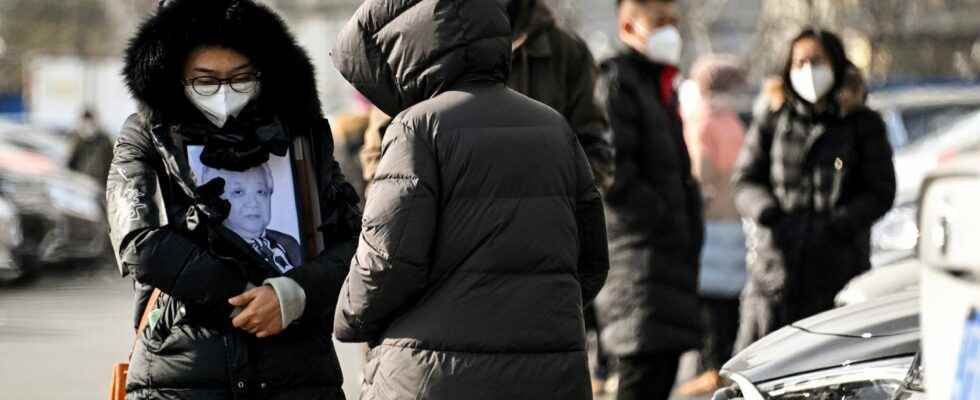A long line of black hearses stretches along the avenue leading to the Babaoshan crematorium, west of Beijing. Undertakers in white “cosmonaut” suits circulate under the watchful eye of police officers who keep curious people away. A phone call to the funeral director is enough to confirm that the waiting list is very long for those who have lost a family member. “Impossible to come during the day”, we are told on the other end of the line. Sometimes you have to pay a small fortune for the removal of a body, confirms a Beijinger who lost his father last week. “He was over 80, he died of Covid before we were able to hospitalize him”.
It is impossible to know the precise toll of the number of victims of this chaotic and brutal end to the “zero Covid” strategy, announced on December 7. “There should be three waves this winter but we must not panic, most of the patients have mild symptoms”, launches without flinching Zhong Nanshan, the chief epidemiologist, long zealous craftsman of the “zero Covid” hard version, become the cantor a relaxation of health control measures.
His speech takes the opposite view of a policy put in place three years ago and which aimed to strictly isolate patients and contact cases. Now, some cities, such as Chongqing or Zhejiang province, are calling on employees to return to work even when they are sick.
Drugs out of stock
Locked up in their Beijing apartment, both sick, a retired couple, not reassured, explains to us how they were taken aback by the virus. “We didn’t even have time to stock up on medicine and food, we got sick with a high fever and a bad cough, at our age it can be dangerous.”
In front of pharmacies in Beijing, customers are trying to buy a few boxes of Paracetamol, “no more than one box per person, warns the pharmacist who announces that the cough suppressants are out of stock. We have had nothing for a week , she said, I don’t know if we can be delivered soon”. Just one month before the Chinese New Year, Beijing looks like a ghost town. All the businesses have certainly reopened, but many employees are sick and the streets are deserted. “It’s strange, you no longer need to scan your health QR code, or do PCR tests. It’s as if none of this had ever existed, testifies a young woman surveying the deserted shops from the Sanlitun shopping district. Everyone around me got sick. Older people are afraid of catching it, but I’ve had it before so I think I can go out normally now.”
Between 60 and 80% of the population will have Covid by the end of winter, assess certain doctors present in China. “We have already counted 130 sub-variants of Omicron, announces the national office for epidemic control. But they are not more virulent”, tries to reassure this body.
The risk of a new variant
“The current wave of Covid represents a major health and humanitarian crisis for China”, underlines François Balloux, director of the Institute of Genetics at University College London, for whom, from an epidemiological point of view, ” the risks to the rest of the world are nonetheless modest to non-existent.” Other Western scientists, however, fear the appearance of a new variant which is not a sub-variant of Omicron. It remains to be seen what its level of virulence would be and if it could contaminate the rest of the planet.
The World Health Organization (WHO) is sounding the alarm: “The WHO is very concerned about the development of the situation in China with the increase in reported cases of serious illness, Tedros said on December 21. Adhanom Ghebreyesus, its Director General In order to carry out a full risk assessment of the situation on the ground, WHO needs more detailed information on the severity of the disease, hospital admissions and medical needs. critical care support”. And to add that the organization was helping China to “focus its efforts on vaccinating those most at risk throughout the country”.
In this area, the government has lost precious time. “Effectiveness against severe symptoms of Chinese vaccines is quite good. But it would have been desirable to organize a vaccination booster campaign and increase the vaccination coverage of the elderly this year. Now it is probably too late for a campaign of this type to have an impact on the current wave”, specifies researcher François Balloux.
A return to normal in the spring of 2023?
Only 40% of people over 80 have indeed received their three doses and no mass vaccination campaign has been launched in recent days despite the promises of the authorities. At the same time, we learned of the delivery to China of doses of Pfizer/BioNTech vaccines by the German government, a promise made during the visit last month of German Chancellor Olaf Scholz to Beijing. But this messenger RNA vaccine, the first available in China, will be reserved… only for German expatriates, i.e. some 20,000 people. Discussions are underway to extend its use to other Europeans (including French) but certainly not to Chinese citizens who remain dependent on national vaccines, Sinopharm and Sinovac.
In the official media too it is a 180 degree turn. The Covid which will soon be renamed “infectious virus” is compared to a simple flu and it is already announced the end of quarantine at the borders from January and the promise of a “normal” life from spring 2023.
“But by then how many people will be dead?, worries the retired couple. We have been locked up for three years and the government has scared us with the Covid! All that to get there”, they sigh. “The end of the ‘zero Covid’ strategy was inevitable. The transition could probably have been better managed,” concludes scientist François Balloux. An understatement, as the lack of preparation seems total.
